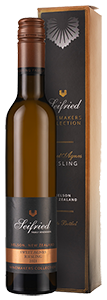Filter by
- A top Asti frizzante – an aromatic, fresh, medium-sweet fizz from Italy’s renowned Piedmont£6.99 per bottleSAVE £1.00
- A breathtakingly delicious sweet Riesling of immense intensity and 13 Trophies since its launch£15.99 per bottleSAVE £2.00
- One of the world’s finest sweet wines, from Hungary’s classic Tokaj region£12.99 per bottleSAVE £3.00
- A delicious, unique, medium white – late-harvest, botrytised Verdicchio with candied apricot fruit£8.99 per bottleSAVE £7.00
- Say ‘hola’ to this lively, no-alcohol fizz – a delicious taste of the great bubblies of Catalunya£4.99 per bottleSAVE £1.00
- No longer just the preserve of grannies, Barbadillo cream sherry is rich, complex and long£12.99 per bottle
- Sumptuous, golden, gloriously sweet – a standout dessert wine from a historic South African estate£14.99 per bottleSAVE £5.00
- World-famous sweet wine from one of “the greatest vintages in its history”£45.00 per bottle
- from £21.00 per bottleSAVE UP TO £3.00
- £175.00 per bottle
- First growth, 6 Puttonyos Tokaji, one of the world’s greatest sweet winesfrom £75.00 per bottle
- £125.00 per bottle
- Showing (1 to 12 of 12)
1
Page 1 of 1
Wine FAQs
What are the most famous sweet white wines?
Sweet white wines come in various styles and are produced in many different wine regions worldwide. Some of the more famous sweet white wines include:
- Sauternes: Produced in the Bordeaux region of France, Sauternes wines typically have juicy tropical fruit and honeysuckle flavours coupled with aromas of butterscotch, citrus, coconut and ginger. Château d’Yquem is one of the most renowned producers.
- Tokaji Aszú: This historic sweet wine from Hungary is made primarily from Furmint and Hárslevelű grapes. The grapes are infected with “noble rot,” which helps create sweet wines with flavours of honey, saffron and juicy stone fruits. The sweetness level varies, with wines labelled with up to six “puttonyos” depending on the concentration of sugar.
- Moscato d’Asti: From the Piedmont region of Italy this sweet, typically gently sparkling wine is made from Moscato (Muscat Blanc) grapes. Its bright flavours include Asian pear, Meyer lemon, fresh grapes and peach, with light floral aromas of orange blossom.
- Riesling: Both Germany and the Alsace region of France are known for their sweet Riesling wines. These can range from “Spätlese” (late harvest) to intensely sweet “Trockenbeerenauslese” or “Sélection de Grains Nobles” (made from grapes affected by noble rot).
- Ice wine (Eiswein): Made in small batches from grapes frozen on the vine and harvested at night, ice wines are intensely sweet and rich. They are typically produced in cold climates, such as Canada and Germany, using Riesling, Vidal Blanc or Gewürztraminer grapes. Ice wine’s perfect balance of sweetness and acidity makes it a lively and refreshing wine.
- Vin Santo: This Italian dessert wine is often made using Trebbiano and Malvasia grapes. Vin Santo’s flavours are rich and concentrated because of its unique production, which sees the grapes sun-dried on straw mats before fermentation. This results in apricots, raisins, orange blossom, nuts and caramel flavours.
How to serve sweet white wine
Serve sweet white wine chilled between 7-12ºC. This cooler temperature lets you enjoy the perfect balance of sweetness, acidity and fruity aromas.
Dessert wines such as Tokaji Aszú should be served cooler – between 6-8ºC. This prevents their intense sweetness from becoming overwhelming.
Richer and more intense dessert wines might benefit from being served slightly warmer to fully appreciate their complexity.
Serve your sweet white wine in a classic dessert wine glass. The shape of this glass is designed to capture the wine’s distinct aromas and reduce the amount of oxygen it’s exposed to.
When can I expect my wine delivery?
The day of your delivery will depend on which option you’ve chosen at checkout.
- For a standard delivery, we will deliver your order in three to five working days. Delivery to the Scottish Highlands, some other areas of Scotland, Northern Ireland and offshore islands can take an extra few days.
- Usual delivery times are between 07.00 and 21.00.
- You can select Next-day or Named-day delivery at checkout – but do bear in mind we don’t deliver on Sundays or Bank Holidays.
For the best experience we recommend you subscribe to our Unlimited service. A one-off payment of £29.99 entitles you to free delivery for a year – including free Next-day delivery. There’s no minimum order – you’ll get free delivery even on a single bottle. And you can get delivery to multiple addresses, so it’s perfect for gifting!
What happens if I want to return a wine?
We want you to enjoy every bottle you buy from us. If you are not completely satisfied with any wine, for any reason, just let us know and you’ll receive a refund.
Plus, we always want you to receive exactly what you need. If we deliver a case and it’s not wanted, just email us at customerservice@laithwaites.com and we’ll take care of it.
Can I get a wine subscription?
100,000 customers already love our wine subscriptions, and enjoy lower prices on their favourites all year round.
With a Laithwaites wine subscription, you can tell us what kind of wine you prefer, and how many bottles you’d like to receive on each delivery.
You can then choose how often you’d like to receive your case – every four or eight weeks. And delivery is free too!














